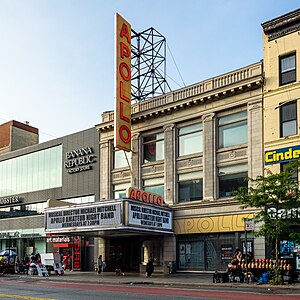
Harlem is a neighborhood in Upper Manhattan, New York City. It is bounded roughly by the Hudson River on the west; the Harlem River and 155th Street on the north; Fifth Avenue on the east; and Central Park North on the south. The greater Harlem area encompasses several other neighborhoods and extends west and north to 155th Street, east to the East River, and south to Martin Luther King Jr. Boulevard, Central Park, and East 96th Street.

Henry Highland Garnet was an American abolitionist, minister, educator, orator, and diplomat. Having escaped as a child from slavery in Maryland with his family, he grew up in New York City. He was educated at the African Free School and other institutions, and became an advocate of militant abolitionism. He became a minister and based his drive for abolitionism in religion.

James McCune Smith was an American physician, apothecary, abolitionist and author. He was the first African American to earn a medical degree. His M.D. was awarded by the University of Glasgow in Glasgow, Scotland. After his return to the United States, he also became the first African American to run a pharmacy in the nation.

The cuisine of New York City comprises many cuisines belonging to various ethnic groups that have entered the United States through the city. Almost all ethnic cuisines are well represented in New York, both within and outside the various ethnic neighborhoods.

Bedford–Stuyvesant, colloquially known as Bed–Stuy, is a neighborhood in the northern section of the New York City borough of Brooklyn. Bedford–Stuyvesant is bordered by Flushing Avenue to the north, Classon Avenue to the west, Broadway to the east, and Atlantic Avenue to the south. The main shopping street, Fulton Street, runs east–west the length of the neighborhood and intersects high-traffic north–south streets including Bedford Avenue, Nostrand Avenue, and Stuyvesant Avenue. Bedford–Stuyvesant contains four smaller neighborhoods: Bedford, Stuyvesant Heights, Ocean Hill, and Weeksville. Part of Clinton Hill was once considered part of Bedford–Stuyvesant.

Ocean Hill is a subsection of Bedford–Stuyvesant in the New York City borough of Brooklyn. The neighborhood is part of Brooklyn Community Board 16 and was founded in 1890. The ZIP code for the neighborhood is 11233. Ocean Hill's boundaries start from Broadway and the neighborhood of Bushwick in the north, Ralph Avenue and the neighborhoods of Bedford–Stuyvesant proper and Crown Heights to the west, East New York Avenue and the neighborhood of Brownsville to the south, and Van Sinderen Avenue and the neighborhood of East New York to the east.
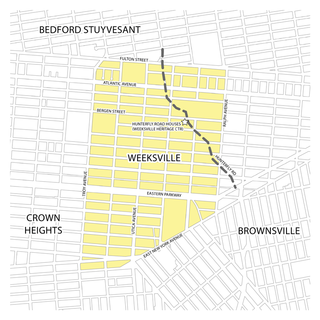
Weeksville is a historic neighborhood founded by free African Americans in what is now Brooklyn, New York, United States. Today it is part of the present-day neighborhood of Crown Heights.
The demographics of Brooklyn reveal a very diverse borough of New York City and a melting pot for many cultures, like the city itself. Since 2010, the population of Brooklyn was estimated by the Census Bureau to have increased 3.5% to 2,592,149 as of 2013, representing 30.8% of New York City's population, 33.5% of Long Island's population, and 13.2% of New York State's population. If the boroughs of New York City were separate cities, Brooklyn would be the third largest city in the United States after Los Angeles and Chicago.
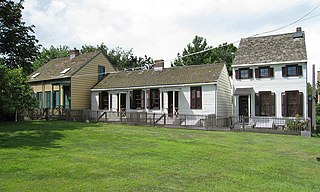
The Weeksville Heritage Center is a historic site on Buffalo Avenue between St. Marks Avenue and Bergen Street in Crown Heights, Brooklyn, New York City. It is dedicated to the preservation of Weeksville, one of America's first free black communities during the 19th century. Within this community, the residents established schools, churches and benevolent associations and were active in the abolitionist movement. Weeksville is a historic settlement of national significance and one of the few remaining historical sites of pre-Civil War African-American communities.

New York County, coterminous with the New York City borough of Manhattan, is the most densely populated U.S. county, with a density of 70,825.6/mi2 (27,267.4/km2) as of 2013. In 1910, it reached a peak of 101,548/mi2 (39,222.9/km2). The county is one of the original counties of New York State.
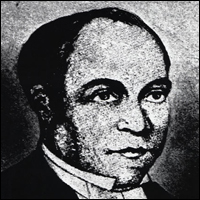
Peter Williams Jr. (1786–1840) was an African-American Episcopal priest, the second ordained in the United States and the first to serve in New York City. He was an abolitionist who also supported free black emigration to Haiti, the black republic that had achieved independence in 1804 in the Caribbean. In the 1820s and 1830s, he strongly opposed the American Colonization Society's efforts to relocate free blacks to the colony of Liberia in West Africa.
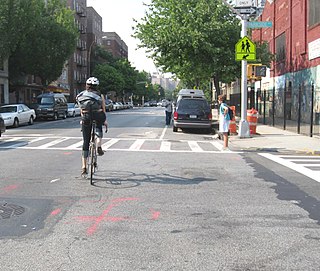
Bedford Avenue is the longest street in Brooklyn, New York City, stretching 10.2 miles (16.4 km) and 132 blocks, from Manhattan Avenue in Greenpoint south to Emmons Avenue in Sheepshead Bay, and passing through the neighborhoods of Williamsburg, Bedford-Stuyvesant, Crown Heights, Flatbush, Midwood, Marine Park, and Sheepshead Bay.

Since its founding in 1625 by Dutch traders as New Amsterdam, New York City has been a major destination for immigrants of many nationalities who have formed ethnic enclaves, neighborhoods dominated by one ethnicity. Freed African American slaves also moved to New York City in the Great Migration and the later Second Great Migration and formed ethnic enclaves. These neighborhoods are set apart from the main city by differences such as food, goods for sale, or even language. Ethnic enclaves provide inhabitants security in work and social opportunities, but limit economic opportunities, do not encourage the development of English speaking, and keep immigrants in their own culture.

The Harlem riot of 1964 occurred between July 16 and 22, 1964. It began after James Powell, a 15-year-old African American, was shot and killed by police Lieutenant Thomas Gilligan in front of Powell's friends and about a dozen other witnesses. Hundreds of students from Powell's school protested the killing. The shooting set off six consecutive nights of rioting that affected the New York City neighborhoods of Harlem and Bedford-Stuyvesant. By some accounts, 4,000 people participated in the riots. People attacked the New York City Police Department (NYPD), destroyed property, and looted stores. Several protesters were severely beaten by NYPD officers. The riots and unrest left one dead, 118 injured, and 465 arrested.

St. Philip's Episcopal Church is a historic Episcopal church located at 204 West 134th Street, between Adam Clayton Powell Jr. Boulevard and Frederick Douglass Boulevard in the Harlem neighborhood of Manhattan, New York City. Its congregation was founded in 1809 by free African Americans worshiping at Trinity Church, Wall Street as the Free African Church of St. Philip. First located in the notorious Five Points neighborhood, it is the oldest black Episcopal parish in New York City. Historically, it was extremely influential both while located in lower Manhattan and as an institution in Harlem, and many of its members have been leaders in the black community. In 2020, it reported 188 members, 111 average attendance, and plate and pledge income of $224,827.
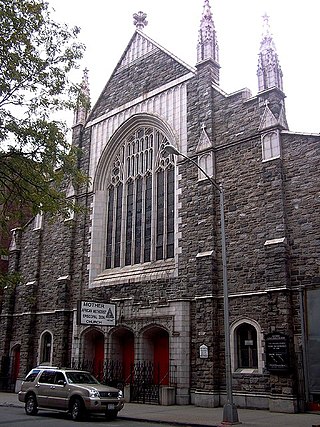
The Mother African Methodist Episcopal Zion Church, also known as "Mother Zion", located at 140–148 West 137th Street between Adam Clayton Powell Jr. Boulevard and Lenox Avenue in the Harlem neighborhood of Manhattan, New York City, is the oldest African-American church in New York City, and the "mother church" of the African Methodist Episcopal Zion conference.

Founded in the 17th century as a Dutch outpost, Harlem developed into a farming village, a revolutionary battlefield, a resort town, a commuter town, a center of African-American culture, a ghetto, and a gentrified neighborhood.

The Bedford Stuyvesant Restoration Corporation is a community development corporation based in Brooklyn, New York, and the first ever to be established in the United States.

The history of African Americans or Black Philadelphians in the city of Philadelphia, Pennsylvania has been documented in various sources. People of African descent are currently the largest ethnic group in Philadelphia. Estimates in 2010 by the U.S. Census Bureau documented the total number of people living in Philadelphia who identified as Black or African American at 644,287, or 42.2% of the city's total population.
The Land of the Blacks was a village settled by people of African descent north of the wall of New Amsterdam from about 1643 to 1716. It represented an economic, legal and military modus vivendi reached with the Dutch West India Company in the wake of Kieft's War. This buffer area with the native Lenape is sometimes considered the first free African settlement in North America, although the landowners had half-free status. Its name comes from descriptions in 1640s land conveyances of white-owned properties as bordering the hereditament or freehold "of the Blacks".


